Driven by the Innovation and Technological Advancement in Display Tech, the Global Digital Signage Market is Forecasted to Reach ~US$30 Bn by 2028, says Ken Research Study.
Digital Signage, as the name suggests, hosts signage on an electronic screen rather than on an acrylic or polycarbonate board. It can showcase any sort of multimedia or audiovisual content to serve the purpose of advertising by brands and marketers or information dissemination by any regulatory agency, government agency, or any similar public broadcasting authority. Digital Signage can vary according to the type of device it is hosted upon, its components, the technology that is being used to run the content, and even the size of the screen. A range of application areas and end-user industries have found Digital Signage to be an effective medium to spread its vision, message, policies, schemes, offers, and more.
“Ken Research shares 3 key insights on this ~US$ 30 billion market from its latest research study”
1. Technological Advancements and Cutting-Edge Display Features Have Helped the Global Digital Signage Market to Grow
The Global Digital Signage market is expected to continue on its growth trajectory at a steady pace during the forecast period of 2022-2028. Innovation in display technology, especially the advent of OLED, MicroLED, and direct-view and fine-pitch LED displays, helped marketers and advertisers to showcase their content in a visually engrossing way. Overall, digital signage has proved its worth in driving a message effectively to its targeted audience.
The Global Digital Signage Market was valued at ~US$15 billion in 2017. The market is estimated to account for a market size of ~US$20 billion in 2022 and grow further to ~US$30 billion in 2028 at a CAGR of ~7% during the forecast period (2022-2028).
 Request For Sample Report @https://www.kenresearch.com/sample-report.php?Frmdetails=NTk2MDMz
Request For Sample Report @https://www.kenresearch.com/sample-report.php?Frmdetails=NTk2MDMz
2. Strong Growth in the Market of Entertainment and Media is Expected to Boost the Market of Digital Signage.
Entertainment is one of the most significant application areas when it comes to leveraging digital signage effectively. It has been seen that millennial and GenZ individuals are more inclined towards personalized content and marketers are allocating a significant share of their advertising budget to digital advertising, including digital signage. According to a report released by the Motion Picture Association in 2021, consumer spending in the global entertainment market again went up to 2019 levels, after a notable dip in 2020. The global digital signage market is expected to benefit significantly from this growth in the entertainment industry.
 3. Digital Signage Marketing is Facing Stiff Competition from Internet Advertising
3. Digital Signage Marketing is Facing Stiff Competition from Internet Advertising
Marketers are allocating a significant share of their budget toward internet advertising. A host of businesses have been found to be relying upon ad-supported internet to attract new customers. According to a study conducted by the Harvard Business School on behalf of the Internet Advertising Bureau, the internet economy has grown seven times faster than the U.S. economy between 2017 and 2021, accounting for nearly 12% of the US GDP. The internet advertising revenue has seen more than 35% annual growth between 2020 and 2021.
 Request For Sample Report @https://www.kenresearch.com/sample-report.php?Frmdetails=NTk2MDMz
Request For Sample Report @https://www.kenresearch.com/sample-report.php?Frmdetails=NTk2MDMz
Key Topics Covered in the Report
- Snapshot of the Global Digital Signage Market
- Industry Value Chain and Ecosystem Analysis
- Market size and Segmentation of the Global Digital Signage Market
- Historic Growth of the Overall Global Digital Signage Market and Segments
- Competition Scenario of the Market and Key Developments of Competitors
- Porter’s 5 Forces Analysis of the Global Digital Signage Industry
- Overview, Product Offerings, and Strength & Weakness of Key Competitors
- Covid-19 Impact on the Overall Global Digital Signage Market
- Future Market Forecast and Growth Rates of the Total Global Digital Signage Market and by Segments
- Market Size of Application / End User Segments with Historical CAGR and Future Forecasts
- Analysis of the Global Digital Signage Market
- Major Production/Supply and Consumption/Demand Hubs within Each Region
- Major Country-wise Historic and Future Market Growth Rates of the Total Market and Segments
- Overview of Notable Emerging Competitor Companies within Each Region
Notable Emerging Companies Mentioned in the Report
- Raydiant
- ScreenCloud
- Waev
- Comeen
- Sparsa Digital
- NoviSign Digital Signage
- Pickcel
- NEON
- Nanovo
- Intelisa
Key Target Audience – Organizations and Entities Who Can Benefit by Subscribing This Report
- Digital Signage Service Providers
- Digital Signage Hardware Manufacturers
- Audiovisual Production Software Companies
- Advertising and Brand Promotion Agencies
- City Municipal Authorities
- Shopping Mall Owners and Chain Retail Businesses
- Transport Companies/ Public Transport Authorities
- Electronics/ Semiconductor Manufacturing Companies
- Out of Home Advertising Companies
- Outdoor Advertising Infrastructure Companies
- Components and Material Suppliers for Digital Signage Equipment
Time Period Captured in the Report
- Historical Period: 2017-2021
- Forecast Period: 2022E-2028F
For More Information on the Research Report, refer to below links: –
Global Digital Signage Market: Ken Research
Follow Us
LinkedIn | Instagram | Facebook | Twitter | YouTube
Contact Us: -
Ken Research
Ankur Gupta, Head Marketing & Communications
+91-9015378249











